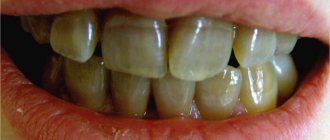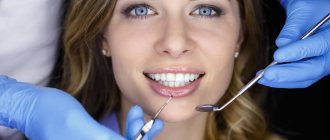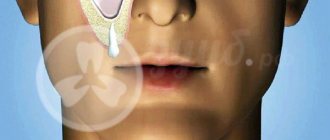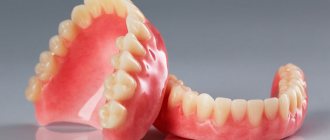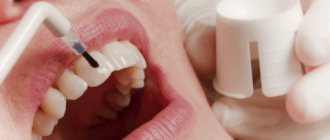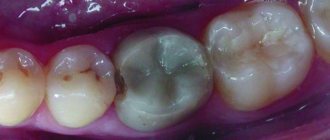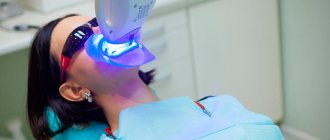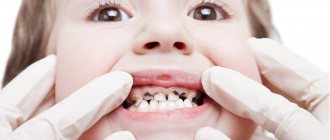The outer shell of the tooth, or enamel, is the strongest mineral structure in the human body. It is harder than bones and is designed to withstand enormous loads when chewing tough food. Tooth enamel is translucent and is only a couple of millimeters thick on the surface of the dental crown. The color of the tooth itself is largely determined by the dentin, which is located under the enamel. The containment shell can withstand pressure up to 100 kg. per tooth, however, such strength properties are still inferior to the effects of long-term loads.
Several primary factors have been identified that contribute to the destruction or thinning of dental tissue.
- Lack of microelements that form the basis of enamel
Studies have shown that the density of hard tissues is heterogeneous in different areas of the tooth. The upper part of the crown has the strongest and thickest layer, reaching up to 2 mm. Approaching the neck of the tooth, the enamel thins to a minimum thickness, which creates vulnerable areas in this area. If there is a lack of calcium, fluoride, vitamin D or other elements in the body, then the most vulnerable area of the crown begins to crack, undergo decay, or expose dentin.
- Genetic predisposition
If close relatives have been identified with unfavorable heredity regarding the health of tooth enamel, then there is a high probability that this predisposition may affect you. Thinning of the upper part of the tooth crown can be caused by an incorrect bite characteristic of the family line or chronic hereditary diseases that affect the strength of the tooth.
- Ignoring the rules of oral hygiene
Brushing your teeth twice a day is not a whim of dentists, but an objectively justified fact that allows you to remove plaque and thereby help reduce the number of pathogenic bacteria. Even the strongest tooth enamel, when exposed to organic acids - waste products of bacteria - is destroyed over time, turning into carious deposits.
- Unbalanced diet with a predominance of carbohydrates and sugars
This is one of the most common causes of premature decay of dental crown tissue. It is sugar-containing products that create a favorable environment for the development of pathogenic microorganisms. Sweets, buns, cakes destroy your teeth, stomach, figure, etc.
- Irregular visits to the dentist
Any changes in the structure of the tooth: cracking, darkening, white spots - all this should alert a person and prompt a visit to the dentist’s office. Ignoring the primary signs of caries or thinning of the tooth crown enamel leads to disastrous results: pulpitis, periodontitis, tooth loss. Of course, this does not happen immediately, but it is the factor of prolonged destruction of hard tissue that lets the patient down: he thinks that there is still enough time.
Content:
- Fluoride varnish
- Why use a fluoride-based protectant?
- Contraindications to the use of fluorine-containing varnishes
- Is it possible to use varnish at home?
- Carrying out the procedure in a dental clinic
- Important nuances
Enamel is the hardest tissue of the human body, but even it becomes thinner over time under the influence of a huge number of different factors.
The procedure of protective coating of teeth with a special varnish allows you to protect the outer shell of the unit and make it more durable. In addition, dental compounds used to treat the teeth of children and adults are a kind of antiseptics. They block the spread of pathogens and thus provide reliable caries prevention.
Most often, when providing a protective coating for teeth, dentists use fluoride varnish. This is a special viscous liquid, including fluorine and other related compounds.
Reviews
Reviews about the use of varnish are contradictory. Some are satisfied with the resulting effect, while others note a lot of shortcomings. Particular attention is paid to the difficulties of self-application and the unnaturalness of the resulting layer.
If you have experience using dental varnish, you can share your opinion by leaving a review in the comments to this article.
If you find an error, please select a piece of text and press Ctrl+Enter.
Tags at home teeth whitening care
Did you like the article? stay tuned
Previous article
Removal of an impacted wisdom tooth: when recommended, features of the operation
Next article
Trainer T4K: who is it intended for, how to use it?
Fluoride varnish
The composition of the varnish, which protects tooth enamel and prevents calcium leaching, includes:
- sodium fluoride;
- shellac;
- fir balsam;
- chloroform;
- ethyl alcohol, etc.
All these substances act in synergy - they provide high-quality disinfection of the treated surface and effectively strengthen it. When enamel comes into contact with sodium fluoride, a hard protective layer is formed. It is thanks to him that the unit ceases to be overly sensitive to salty, spicy and sour foods, and temperature changes.
The mixture has a positive effect on the condition of the gums. After its use, soft tissues become less inflamed and bleed less.
Light teeth polishing (Conclusion)
Completion of a composite restoration involves a routine procedure—surface polishing. This gives a finished look to our work and reduces the fixation of plaque on the surface of the composite.
The use of new composite resins makes the polishing procedure as easy as possible, aesthetically more effective and stable. In addition, the BisCover composite glaze has a multifunctional purpose: a surface sealant on the chewing surface, a protective sealant in the practice of orthodontists, it is possible to seal fissures during intact intervention, and cover indirect restorations made of composite material (inlays, crowns).
Modern developments allow us to get the desired result more predictably. However, as with everything, it is important to follow the technology for working with BisCover and enjoy the result.
Why use a fluoride-based protectant?
Fluoridation is prescribed to young children to avoid tooth decay. After all, it is very important to keep the milk units healthy until they are replaced. How many years the molars will last largely depends on their condition.
Other indications for enamel coating include:
- Restoration of the natural mineral structure of hard tissues. Fluorine is able to “pull” the necessary minerals from saliva, due to which an active saturation reaction occurs.
- Prevention of premature crown wear. If the tooth is healthy, the problem of abrasion will not arise, so you need to monitor the condition of its tissues.
- High sensitivity. It can be hereditary or provoked by rough mechanical influences performed by dental procedures (for example, whitening).
- Wedge-shaped defect. With this diagnosis, tissue is destroyed in the cervical area. Moreover, the destructive process is in no way related to caries.
It is advisable to cover your teeth with a protective coating after professional ultrasonic cleaning. In general, this procedure will be useful to almost all patients of the dental clinic (with the exception of those who have contraindications to its implementation).
Indications and contraindications
Recently, dental varnishes have become in demand.
Their use is considered appropriate for the following indications :
- the presence of carious lesions at the spot stage;
- enamel hypersensitivity;
- surface microdefects;
- high permeability (thinning) of enamel;
- pigmentation of crowns as a result of consuming coloring products, bad habits, or after taking certain medications;
- fluorosis;
- pulp diseases.
The use of varnish allows you to temporarily solve the problem of color mismatch between fillings and the main surface of the tooth.
The use of correctors is not always possible. contraindications for this :
- age up to 19 years;
- intolerance to components;
- allergic manifestations;
- period of pregnancy and breastfeeding;
- for some types of varnishes – high sensitivity of enamel;
- severe damage to crowns: carious cavities, large chips;
- pathology of periodontal tissue;
- advanced dental diseases;
- dental injuries.
Is it possible to use varnish at home?
It is allowed to carry out a strengthening procedure at home, but you should still consult a doctor first. Difficulties will arise already at the stage of purchasing varnish - you won’t be able to find a high-quality and safe solution on the open market. It must be ordered from a dental center or specialized medical store.
If you do find a drug and the dentist allows you to use it yourself, do not forget about the rules:
- pre-dry your teeth using cotton swabs;
- apply the product in a very thin layer;
- The varnish should dry naturally for about 5 minutes;
- Do not eat anything for twelve hours after the procedure.
What it is?
The main role of whitening varnish is to temporarily mask the pigmented surface of the crowns.
Many people compare the functions of this product with foundation. It is also applied to the enamel, covering it with a glossy layer, the color of which is several times whiter than the crowns.
Unlike other lightening agents, varnish allows you to even out the color even in filled teeth. The product is easy to use and does not require special preparation of crowns.
The main components in them are :
- protective film-forming agent;
- titanium dioxide , which performs a coloring function;
- mineral and fluoride additives , such as hydroxyapatite and fluorides.
The use of varnish is recommended to strengthen the enamel in case of poor quality, pigmentation and uneven surfaces (cracks, small chips).
It is common to use the product for photo and video filming or important life events, since the corrector makes it possible to obtain instant results.
Manufacturers often guarantee that the layer will remain intact for 12-24 hours, but often its integrity is compromised within 4 hours of application.
Carrying out the procedure in a dental clinic
Dental treatment in a dental clinic is much more effective than at home.
Before proceeding with the manipulation, the doctor carefully cleans the dental crowns from hard stone and soft plaque. Due to this, the fluoridated gel adheres better to the enamel and penetrates into its deeper layers. Afterwards, the work area is isolated from saliva. This is very important and a person is not able to do this on his own. The dentist then uses fluoride varnish. He carefully distributes it over all surfaces, making sure that not a single area is left untouched. Until the solution dries, the person sits with his mouth open.
An experienced dentist knows exactly how much varnish to use and how to apply it correctly. Therefore, the patient does not risk anything. He can be confident in the effectiveness of the therapy.
Application of a protective tooth coating
So, where can BisCover be used:
1. As a composite glaze for the restoration of central teeth. (Fig. 5)
2. Covering the surfaces of old restorations (yours or someone else’s). In this case, the surface of the restoration must not only be etched with orthophosphoric acid, but also sandblasted (Fig. 6)
3. As a resin - a sealant for the restoration of the chewing surface. (Fig. 7) In this case, we get not only a shiny surface but also long-term protection of the composite-tooth enamel interface.
4.Like true composite glaze on inlays and crowns made of composite material (Fig.
5. In orthodontics. Please note what may accompany the post-orthodontic situation. In this clinical case, you see foci of demineralization in the area of fixation of the bracket system. (Fig. 9) Orthodontic patients are smart.
I'm sure they are especially careful to clean everything, but the arch and fixing elements are in the way around the braces. After treatment, as a rule, remineralizing therapy is required, and for some this ends with restoration procedures. Today we can fully help such patients.
Important nuances
In order for the use of a fluoride-containing product to be effective, it is important to remember some points:
- After manipulation, it is prohibited to use pastes containing fluoride. This leads to an excess of the component in the body and causes the development of fluorosis.
- Treatment can only be carried out according to medical prescription. Between procedures, intervals determined by the dentist on an individual basis should be maintained.
- Pregnant women are recommended to strengthen their enamel with fluoride. During this period, calcium is actively washed out of the expectant mother’s body. To keep it in your teeth, you need to coat them with varnish. But in case of severe toxicosis, fluoridation is strictly contraindicated.
- Fluoride varnish should be applied after removing braces, during breastfeeding, and after gum disease.
The manipulation can be performed for the first time when the child turns two years old. Then it is done according to indications. Adults should use a fluoride-containing composition at least once a year, immediately after professional oral hygiene.
Creating glitter
Most often, when restoring central teeth, doctors use materials that, upon detailed study, can be classified as microhybrid composites. This is something average. Both strength is present and shine can be created with certain (sometimes heavy) efforts.
In 2002, a unique development was created for these purposes—the liquid polisher BisCover (Bisco). The Bisco company positioned BisCover as a resin sealant, unfilled, especially wear-resistant and imparting an excellent shine to the treated surface. You know that when any composite material polymerizes in the presence of oxygen, an oxygen-inhibited layer is formed on the surface. It may have different thicknesses between adhesive systems and composite materials.
When the surface of the composite is polymerized, the oxygen-inhibited layer of the composite material looks shiny, but if this layer is removed mechanically, the surface of the composite will become dull. (Figure 1).
Bisco has been able to develop a version of the unfilled resin that, given sufficient energy flow, is able to polymerize completely without an oxygen-inhibited layer. And it looks shiny (Figure 2).
The new version of BisCover is based on the photoactivator CQ (camphoroquinone) and has an energy absorption spectrum at a wavelength of 468 nm, that is, it can be polymerized by all types of light sources (halogen, plasma, argon and LED polymerizers). The effect of BisCover (I call it “composite glaze”, with a similar purpose as for ceramics – “ceramic glaze”) was observed in practice on the first fixed case, 2 years after application. (Fig.3)
Please note that the shine of the enamel of the adjacent tooth is similar to the shine of the restored surface coated with BisCover. Further, the use of BisCover was targeted, and today I can show you cases from a 7-year observation period. BisCover shows itself especially clearly when restoring central teeth. It is important to convey not only the color and shape of the adjacent symmetrical tooth, but also to reveal the microtexture.
After creating the macro shape of the marginal ridges, the surface is drawn out with 12-sided burs. It takes on the appearance of an even cut (smooth) texture. Under no circumstances should the surface be polished to a “mirror shine” before applying the composite glaze. This will reduce the adhesion of the resin. She will "slip".
Next, using diamond burs with a red notch, we create the surface microtexture according to the planned scheme. We hold the bur in our hand and make filing movements along the edge ridges, simulating growth lines and minor depressions. After all this, the surface is etched with orthophosphoric acid Uni-etch 37% (Bisco) (in fact, the acid does not etch the surface of the composite, the task is to chemically clean it from the organic substance, because the patient closed his mouth).
A layer of BisCover is dried and applied, left for literally 5 seconds, the solvent evaporates, and polymerized for at least 30 seconds at the power of your polymerization lamp 500mW/cm2. As a result, you get the development of microtexture, the play of light on the surface of the restoration and a brilliant “glazed” appearance. Do not be alarmed if you notice a slightly grayish tint to your restoration after applying the resin. This phenomenon is temporary and optical. You won't notice anything at your next visit.
The polymerized resin has a transparent appearance (Figure 4).
Modern methods of treatment
The technological advancement of processes does not stop, so modern medicine, improving, is ready to offer innovative methods that can solve the problems of pathological abrasion of tooth enamel, eliminate cracks in the shortest possible time and quickly level the surface of the crown.
These include, for example, enamel implantation, which can restore even severely damaged teeth. A qualified clinic specialist creates a material that, in its external characteristics, is indistinguishable from natural enamel. With its help, an organic replacement of the destroyed part of the tooth occurs.
Using this method, you can cosmetically correct a defective bite. If a person takes proper care of their oral cavity, such an implant will last for decades.
Dental onlays deserve special attention, allowing the client to achieve the effect of the famous Hollywood smile. They are divided into two types:
- Lumineers
- Veneers
The key difference between them is the fact that when placing lumineers, teeth are not ground down, and in terms of external characteristics they are much thinner. Doctors recommend resorting to this technique if all other methods have already been tried.
It is worth noting that, despite the fact that strong and durable porcelain is used in the manufacture of onlays, even with careful care, the products become unusable over time. The average length of their service is approximately 15 years.
Among the advantages, of course, stands out the ability to completely cover all existing defects of tooth enamel, hide or clearly reduce the dental space, as well as mask the incorrect position of the tooth in the socket.
Kryolan
Paints of various shades are produced under the Kryolan brand. They are used to a greater extent to achieve a cosmetic effect. The drug does not have a significant therapeutic effect, since it does not contain antiseptics and is not able to preserve minerals.
The cost of enamel is about 680 rubles. The volume of the bottle is quite large - 12 ml. However, this paint cannot be used every day. It interacts with carbonated drinks and food. Therefore, enamel can only be applied for a few hours. Then it must be removed with a toothbrush.
Features of recovery for severe enamel damage
In case of severe damage, the doctor may suggest other methods for restoring tooth enamel, the price of which will be significantly higher than fluoridation:
- Enamel implantation.
This is the process of its restoration at the molecular level. A substance similar in composition to natural enamel is applied to the teeth. It adheres to the native enamel and becomes an inseparable part of it, continuing to perform natural protective functions.
- Installation of veneers.
A rather radical method that does not involve restoring enamel, but installing the thinnest ceramic plates on the front of the teeth. Installation of veneers requires preparation of natural enamel, but at the same time allows you to achieve an excellent aesthetic effect. Veneers reliably protect teeth in case of chips and cracks in enamel.
Celebrity White Flash
This white tooth paint works great to brighten enamel. At the same time, it has a pronounced therapeutic effect - it strengthens dental tissue and preserves minerals. It can be used to prolong the effect of professional whitening.
The cost of paint is about 500 rubles. It is packaged in a pen-shaped bottle. It is important to remember that this product takes a long time to dry. After applying it, you must refrain from eating and drinking for 1 hour.
"Colordent"
White varnish-paint for teeth "Colordent" contains antiseptic substances. This product whitens enamel by 10 tones and preserves minerals in tooth tissue. The drug is packaged in a pen bottle. It is easy to use. Even a child can apply this varnish on his own, since the composition of this product is safe.
Colordent is applied every day and removed with a toothbrush. This product takes quite a long time to dry, and its effect is short-lived. The cost of paint in pharmacy chains ranges from 1,500 to 2,000 rubles.


